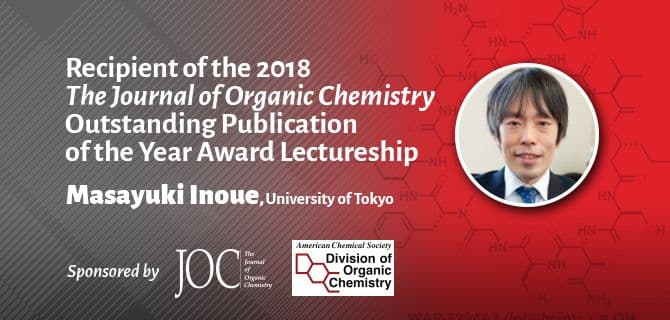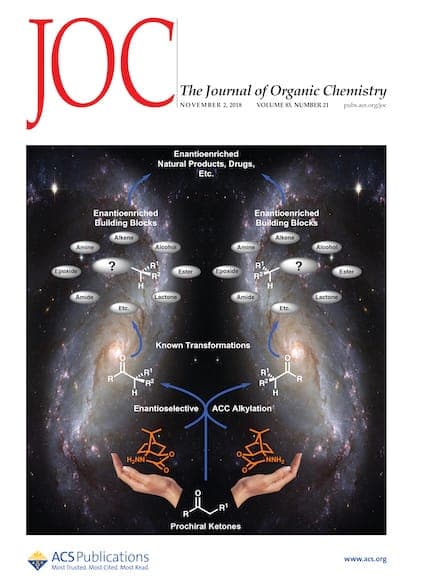Masayuki Inoue, Chemistry Professor at the University of Tokyo, is the 2018 recipient of The Journal of Organic Chemistry Outstanding Publication of the Year Award Lectureship.

Masayuki Inoue, Chemistry Professor at the University of Tokyo, is the 2018 recipient of The Journal of Organic Chemistry Outstanding Publication of the Year Award Lectureship. The Journal of Organic Chemistry and the ACS Division of Organic Chemistry sponsor this annual award, which honors the author of an outstanding article published in the previous calendar year that demonstrates creativity and impact in the field of organic chemistry.
Inoue, who is also a JOC Associate Editor, was selected for this award because of the work his group did in synthesizing the antibiotic WAP-8294A2, known as lotilibcin, and describing how it works to wipe out the drug-resistant “superbug” MRSA (methicillin-resistant Staphylococcus aureus), which they reported in the article “Total Synthesis and Biological Mode of Action of WAP-8294A2: A Menaquinone-Targeting Antibiotic.” WAP-8294A2 was isolated from a soil sample and first reported in a Journal of the American Chemical Society paper “WAP-8294A2, A Novel Anti-MRSA Antibiotic Produced by Lysobacter sp.” in 1997. Because it’s very effective against MRSA, it is being developed as a potential new drug.
“We are delighted to celebrate this superb paper by Professor Inoue’s group describing detailed studies of both the total synthesis of a highly complex, macrocyclic peptidic antibiotic and related analogs, as well as function-oriented studies unveiling aspects of the compound’s profound biological activity,” says The Journal of Organic Chemistry Editor-in-Chief Scott J. Miller. “We are grateful also to the authors and nominators of many truly outstanding papers for the lectureship award, and I am also grateful to our independent committee that performed the challenging work of selecting the winner.”
Read all of Masayuki Inoue’s articles from ACS Publications.
As the recipient of The Journal of Organic Chemistry Outstanding Publication of the Year Award Lectureship for 2018, Inoue will present a lecture at an ACS Division of Organic Chemistry session in his honor at the 256th ACS National Meeting & Exposition in Boston. The session will also celebrate Tehshik P. Yoon, recipient of the Organic Letters Outstanding Publication of the Year Award Lectureship for 2018.
An Interview with Masayuki Inoue
I connected with Inoue recently to learn more about his research and his career in organic chemistry. These are the highlights of our conversation.
How long have you been studying WAP-8294A2 and what made you interested in this line of investigation?
In 2012, Professor Kazuhisa Sekimizu, who’s now retired from our department, asked me if I was interested in synthesizing a new antibiotic, which was isolated in his laboratory. This peptide antibiotic was later named lysocin, and its mode of action was shown to be distinct from those of any other reported antibiotics. Fascinated by this unique activity, we eventually achieved a total synthesis for lysocin and elucidated its structure-activity relationship. These detailed studies led us to recognize that all of the biologically important functionalities of lysocin are shared by a structurally distinct antibiotic WAP-8294A2.
WAP-8294A2 has potent bactericidal activity against otherwise antibiotic-resistant Gram-positive pathogens, but its mode of action had been unknown since its isolation in 1997. These motivated us to launch our investigation on WAP-8294A2 in 2015. The paper reports the first total synthesis of WAP-8294A2 and the identification of menaquinone as its molecular target, which is an essential factor for electron transfer in the bacterial respiratory chain.
What do you find fun and exciting about natural product synthesis?
It is always fun for me to look at complex and beautiful architectures of natural products and to imagine how those three-dimensional shapes can be assembled from simpler materials. Execution of total synthesis is not as easy as designing, and takes a significant amount of time, but is highly rewarding.
Most useful ideas sometimes come when facing seemingly dead-end and hopeless situations. Through synthesis, we can learn many facets of contemporary organic chemistry, develop new methodologies and strategies, and discover unknown biological properties of natural products. Natural product synthesis provides these diverse exciting opportunities, which I think are unparalleled by any other endeavor in organic chemistry.
How do you think the work you described in your award-winning paper will influence the further development of WAP-8294A2?
WAP-8294A2 is more active than vancomycin in an experimental systemic methicillin-resistant Staphylococcus aureus (MRSA) mouse infection model. Our full solid-phase strategy for the synthesis of WAP-8294A2 enabled rapid preparation of a wider variety of analog. The stage is now set for the optimization of the antibacterial activity and the structural determination of the co-complex between WAP-8294A2 with menaquinone. The finding from these studies should provide the foundation for the development of novel antibiotics against MRSA with the unique mechanism.
What’s next in your research?
Our research group focuses on efficient, practical, and flexible syntheses of biologically important natural molecules, including peptides and terpenoids. Specifically, we are aiming to develop highly convergent strategies for making complex structures from simple fragments.
Such strategies would provide sufficient amounts of synthetic compounds, which is a key to uncovering their biological functions. They would also allow for the unified synthesis of modified variants for detailed structure-activity relationship studies. Eventually, these studies together should expand the biologically relevant chemical space and accelerate the discovery and development of novel therapeutic agents based on these highly complex natural products.
Is there anything else you’d like to share?
I would especially like to acknowledge an inspiring and dedicated group of past and present senior colleagues and graduate students. I have learned so much from them over the years. For this particular paper, I sincerely thank Dr. Hiroaki Itoh, an assistant professor; Mr. Kotaro Tokumoto and Dr. Takuya Kaji, graduate students in my laboratory; and Professor Sekimizu and his laboratory members, who collectively did all the work.
